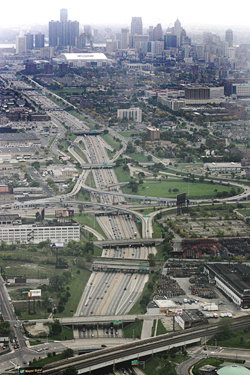Shrinking cities
 Greetings From Detroit, Michigan postcard, from Curt Teich Postcard Archives.
Greetings From Detroit, Michigan postcard, from Curt Teich Postcard Archives. Is the cover story in today's USA Today. This is a tough issue. Planning for contraction is one of my interests, even though I tend to work in areas where this is less of an issue, at least today. Although the article misses some of the nuances of the issue, it's still pretty good.
I have been especially intrigued by this phenomenon ever since I came across a mention of the Youngstown 2010 initiative, and reports of upstate New York towns like Syracuse having an active program to tear down houses that had been vacant for many years. And of course, there is the story of Detroit, my hometown, which today, of the city's 140 square miles, almost 1/3 is now fully vacant land.
But the real issue is the (continued) outmigration of residents from center cities to the suburbs, and then further and further out. Detroit is a perfect example (until the latest recent failure of the U.S.-based automobile manufacturers).
Over the 40 years from 1960, the population in Wayne, Oakland, and Macomb counties didn't increase much--200,000 people more in the 2000 Census (of course, the outlying counties added population, and were amalgamated into the SMSA for Detroit). The difference is that 1.1+ million people moved out of Detroit and its relatively compact 139 square miles for other (non-Detroit) 1,789 square miles in the tri-counties.
 S.S. Kresge on Woodward Avenue, Detroit, 1934. Detroit News photo copyright Wayne State University.
S.S. Kresge on Woodward Avenue, Detroit, 1934. Detroit News photo copyright Wayne State University.And a friend-colleague, as well as James Howard Kunstler, argue that because of peak oil and the depletion of relatively cheap and efficient (high return in energy for the amount used) gasoline, the suburbs will be abandoned, and people will come back to cities.
In short, Richmond Virginia, in an area of the country that is still growing, has different options compared to a city like Cleveland. Cleveland has shrunk greatly, but at the same time, the region isn't growing either. That is a problem in the old industrial midwest, and in the upstate regions towards the border with Canada.
 Motown Fan Club promotion. Artifact abandoned in the Motown building when the company moved to California. Spelunked by Detroit Blog. Building demolished in 2005 in advance of the Super Bowl.
Motown Fan Club promotion. Artifact abandoned in the Motown building when the company moved to California. Spelunked by Detroit Blog. Building demolished in 2005 in advance of the Super Bowl.OTOH, cities along the coasts, including Richmond and Baltimore, still have locational advantages not possessed by cities like Detroit, Cleveland, or St. Louis. (And this is one of the reasons that I favor "urban growth boundaries" to recenter growth in places of extant infrastructure, to preserve open spaces, to provide the opportunity for efficient transit, etc.)
--------
The "solution."
Places like Flint and Detroit are going to shrink, because their economies are tied to industrial companies (not the industry in general) that are not able to reengineer. And places like upstate New York will never be central to manufacturing in the way that they were when water, both as a source of energy and as a mode of transportation, was so much more important. (Hmm, ample supplies of water will matter again, as aquifers in the south are depleted through increased use because of population growth.)
 David Coates. Detroit News.
David Coates. Detroit News.Other than urban growth boundaries, I think declining cities have to focus their resources on stabilizing potentially attractive neighborhoods, neighborhoods attractive to people with choices. And that is going to have to mean great schools as well, which is a whole other issue, as municipal governments, especially public school systems, have the same kinds of issues wrt innovation possessed by General Motors and Ford.
There may be no hope for GM and Ford. We'll see. In any case, these companies will shrink even further and will never more be the source of employment for entire cities (Flint, Saginaw, Lansing, Pontiac, Detroit, Dearborn--all in Michigan) as they were in the 1940s, 1950s, and 1960s.
Are our municipal government institutions destined to the same fate, or do we have the public will to right these institutions, and improve them after allowing decades of decline and neglect?
And for cities like Baltimore, they have to understand that their competitive advantage within their region is tied to efficient transit. Baltimore will have to step up to the plate and take control of their transit agenda, which is currently directed more by the state than by the city. Of course, they'll have to jettison their urban renewal orientation as well.
 I-94 and I-75 interchanges, Detroit. Wayne Smith, Detroit News.
I-94 and I-75 interchanges, Detroit. Wayne Smith, Detroit News.Index Keywords: urban-revitalization



0 Comments:
Post a Comment
<< Home